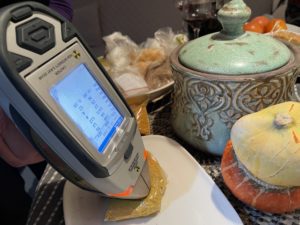In 2020, Pure Earth investigators helped to unravel the mystery of widespread lead poisoning in Georgian children. They traced the problem to contaminated spices found during home investigations. The source of the poisoning was lead chromate, a dye that was being added to spices to enhance color. Fortunately, the government took swift action, passing regulation that eliminated most lead chromate from the spice market within two years.

But with 41% of children ages 2-7 in the Republic of Georgia with blood lead levels over 5 μg/dL, fixing the problem will take even more research and coordination.
That’s why Pure Earth and UNICEF followed up with a workshop in September 2021 for 20 representatives from the public and private sector, including the National Center for Disease Control and Public Health (NCDCH), the National Environmental Agency (NEA), the National Food Agency (NFA), and the company Takeda Motors.
After Nino Dotsenidze of UNICEF presented the Protecting Every Child’s Potential project, participants watched a video about lead-contaminated spices in Bangladesh, featuring researchers from Stanford University. Pure Earth then shared the initial results from the national spice assessment in Georgia, highlighting the pathways that lead finds its way into the supply chain.

For their part, each governmental department described their efforts to combat lead contamination, as well as areas where they need additional support. In particular, the parties highlighted the need to build government capacity in lead assessment and to study lead in family homes, rather than just in the market. By the end of the meeting, Pure Earth and UNICEF agreed to help the NCDCH carry out regional assessments in family kitchens and host a technical workshop for regional and national officials.
Pure Earth wasted little time in following through with these commitments.
Two months after the virtual meeting, Pure Earth Georgia Country Director Khatuna Akhalaia led a technical training for 12 officials, including representatives from the NFA, the Mtskheta-Mtianeti Regional Government, and the City of Tbilisi’s Food Safety Agency.

After a presentation on lead-adulterated spices and pigments, officials learned about the technical aspects of measuring lead in the laboratory and with an XRF (X-ray fluorescence) analyzer, a handheld device that can rapidly measure toxic metals such as lead. The Pure Earth team also brought bagged samples of lead-adulterated spice to the event, giving participants a chance to experiment firsthand with the device.
Each participant left the training with basic technical know-how of lead assessment as well as a pamphlet on lead chromate in spices. (see below)

These workshops marked the initial steps of a national effort to eliminate lead contamination from the kitchen, but there is still much work to be done. Moving forward, Pure Earth and partners plan to hold another technical workshop for officials from the Western regions of Georgia, as well as work with representatives from the Region of Adjara to take spice samples in family homes.
This post comes from Charlie Espinosa. This work was possible thanks to the generous support of the Clarios Foundation.




